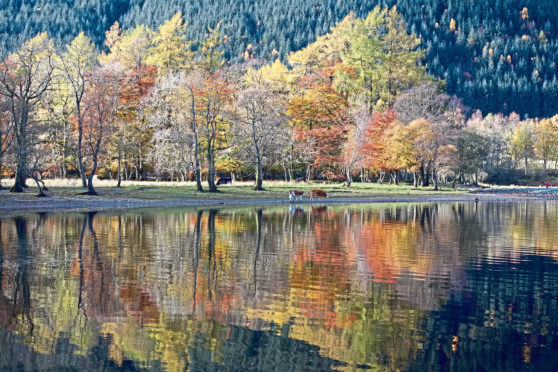We may not have had an Indian summer (or any other kind now that I think about it), but oh, what an autumn for colour! Some obscure law of nature or human perception or both (we are nature ourselves after all) seems to dictate that the cloudier and gloomier the autumn day, the more intense the colours.
We are in among the days now of the embers of the season’s fire, the weekend storms blasted away the last of the deep shades, but what’s left is what I love best, when the colours pale from in-your-face oils to easier-on-the-eye watercolours. The effect is nowhere more painterly than among larch trees.
I had found Loch Lubnaig in a particularly beguiling mood. It was flat calm, but in the total absence of anything like bright daylight it was opaque as ice. Yet still it fed back the dark greens of spruce and pine, the all-but-black of bare rock, the imperceptibly whitened mountain ridges, and in the midst of all that were the startling slashes and curves and twisted ropes of larches just past their prime, and simply smouldering.
In the forest itself under the mountains, the surface of the track changed colour every time it passed beneath a stand of larches for it acquired a faded orange carpet of larch needles. And the orange had been badger-striped black by the passage of forestry vehicles, so that there were three orange stripes and two black. Where a narrower path diverged from the main forest track, the effect was more marked – two orange stripes and one black down the middle, and that was the work of deer, fox, pine marten, actual badger, and one wandering nature writer with a screw loose, contriving imaginary art exhibitions that ennobled the land at every turn.
Elegance and dignity
In a clear-felled patch where a handful of larches had been spared, only the tallest of the group had any needles left at all and these were straw-shaded. I had the slightly left-field notion of a beautiful woman with grey hair, and how, in the right circumstances, that adds elegance and dignity to the beauty.
I stopped to watch, tried to draw it, but the act of drawing, and more importantly the stillness, meant I was in the right place when a softly jabbering, wing-fluttering cloud of something-or-other hurtled across the clearing a yard above the ground then rose and burst apart to perch all over the larches. Green, patches of yellow, sooty skullcaps of black: Siskins. Larches have ripe seeds in autumn, a trait they share with Sitka spruces. The growth of commercial forestry across Scotland has hefted the seed-eating siskin population from half a million to around five million when the natives are joined in the autumn by swarms from mainland Europe. In good binoculars, such an inundation on such a tree on such a day is a mobile masterpiece of nature’s art, in my head at least.
Floodwater on the fields of the Carse of Stirling, the valley of the Upper Forth, and shallow pools on top of some of the best grass in the land lures waders, swans and geese. It’s a routine to drive the skinny farm roads through the fields rather than the main road when I’m heading back from somewhere further north. This time there was a dark stain far out in one of the fields. It could be anything or nothing, but experience teaches the worth of taking the trouble to stop when there is something unfamiliar in a familiar landscape. If it’s nothing, you have spent a couple of minutes finding out. But if it’s something…
Smoored gold and black
So I stopped and in the binoculars the dark stain turned out to be a flock of more than a hundred golden plovers. I like golden plovers, not least because they lend their shades of smoored gold and black to these autumn and winter fields, and on the high ground to the north they keep the company of golden eagles (and sometimes pay for the privilege with their lives).
It took 10 minutes to follow a rough track out to some dead trees and these gave me the cover I needed to watch the flock. They fed around the edges of floodwater. These autumn and winter flocks appear to feel more secure when they can feed through shallow water. Lapwings, curlews, oystercatchers all do it, too. The flock rippled as it moved, like high tide at slack water, the shallowest of undulations rather than waves, then first hints of an inches-high surge as the tide sighs and begins to turn. These are surely the most beautiful of our wader tribes, and they offered supreme birdwatching elegance at 50 yards.
And this was my “dark stain”. This was why I took the trouble to stop because sometimes, as I know all too well, it will be nothing at all, but sometimes it will be a pot of gold. What an autumn for colour, and it’s not quite done yet, for these are still the last of the watercolour days.










